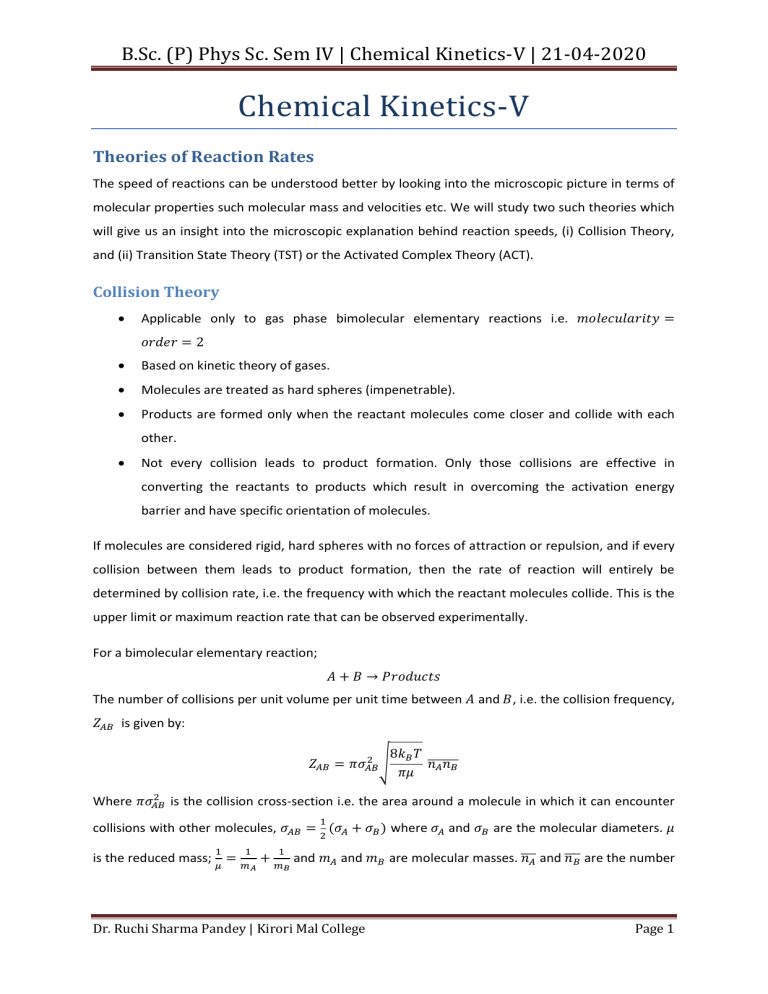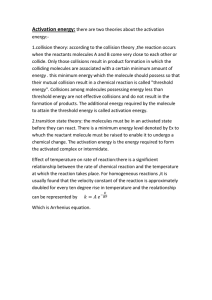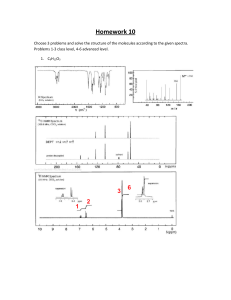
B.Sc. (P) Phys Sc. Sem IV | Chemical Kinetics-V | 21-04-2020 Chemical Kinetics-V Theories of Reaction Rates The speed of reactions can be understood better by looking into the microscopic picture in terms of molecular properties such molecular mass and velocities etc. We will study two such theories which will give us an insight into the microscopic explanation behind reaction speeds, (i) Collision Theory, and (ii) Transition State Theory (TST) or the Activated Complex Theory (ACT). Collision Theory Applicable only to gas phase bimolecular elementary reactions i.e. Based on kinetic theory of gases. Molecules are treated as hard spheres (impenetrable). Products are formed only when the reactant molecules come closer and collide with each other. Not every collision leads to product formation. Only those collisions are effective in converting the reactants to products which result in overcoming the activation energy barrier and have specific orientation of molecules. If molecules are considered rigid, hard spheres with no forces of attraction or repulsion, and if every collision between them leads to product formation, then the rate of reaction will entirely be determined by collision rate, i.e. the frequency with which the reactant molecules collide. This is the upper limit or maximum reaction rate that can be observed experimentally. For a bimolecular elementary reaction; The number of collisions per unit volume per unit time between and , i.e. the collision frequency, is given by: Where is the collision cross-section i.e. the area around a molecule in which it can encounter collisions with other molecules, is the reduced mass; where and and Dr. Ruchi Sharma Pandey | Kirori Mal College and are the molecular diameters. are molecular masses. and are the number Page 1 B.Sc. (P) Phys Sc. Sem IV | Chemical Kinetics-V | 21-04-2020 of molecules of and per unit volume. is the Boltzmann constant and is the average speed of the molecules. The maximum rate of the reaction in terms of collision frequency can then be written as; In terms of concentration and and The rate can also be expressed in terms of concentration as; Where, comparing the two equations In reality, only those collisions result in product formation, where the energy acquired by the molecules after collision, is greater than the threshold energy. where Remember And the fraction of molecules possessing energy equal to factor where, is given by the Maxwell-Boltzmann is the average kinetic energy of the molecules and hence the rate of reaction can be written as; Dr. Ruchi Sharma Pandey | Kirori Mal College Page 2 B.Sc. (P) Phys Sc. Sem IV | Chemical Kinetics-V | 21-04-2020 And we know that; , on comparison we get; second order rate constant from collision theory Collision theory gives good results for simple molecules but the rate constant does not satisfactorily match exponential results for complex molecules. It was later found that the rate of formation of products depends not only on but also on the orientation of molecules at the time of collision. An additional factor needs to be introduced into the equation for where is called the steric factor. It is usually less than 1. So, Comparing Collision Theory and Arrhenius Equation According to Arrhenius equation; k Ae Ea / RT or ln k E a2 T RT The rate constant from collision theory is written as natural logarithm of And if we take and take its derivative w.r.t , we get Dr. Ruchi Sharma Pandey | Kirori Mal College Page 3 B.Sc. (P) Phys Sc. Sem IV | Chemical Kinetics-V | 21-04-2020 On comparing the differentials of rate constant from Arrhenius theory and collision theory, we get Ea 0 The rate constant can then be written as RT 2 if we compare the two rate constants, we can obtain the Arrhenius pre-exponential factor as; Activated Complex Theory, or Transition State Theory Eyring, Polanyi and Evans proposed that the reactants transform into products via the formation of a short lived high energy configuration of molecules called as the activated complex (AC) or the transition state (TS). They postulated; Reactant molecules must collide; Molecular collisions must occur with proper orientations; Collisions must be energetic and lead to the formation of the transition-state complex; The rate of formation of the transition-state complex is the rate determining step; The transition-state complex eventually leads to the formation of products Dr. Ruchi Sharma Pandey | Kirori Mal College Page 4 B.Sc. (P) Phys Sc. Sem IV | Chemical Kinetics-V | 21-04-2020 The transition state or AC, which is formed is an unstable species that contains partial bonds. It is a transitional species between reactants and products. cannot be isolated. exists at the point of maximum potential energy. The energy required to form the transition state is the activation energy. Has two fates: ● it can either dissociate and return to become the reactants, or ● rearrangement of bonds in AC can lead to product formation Dr. Ruchi Sharma Pandey | Kirori Mal College Page 5 B.Sc. (P) Phys Sc. Sem IV | Chemical Kinetics-V | 21-04-2020 For a bimolecular gas phase reaction; where, is the second order rate constant of ACT The mechanism as per the activated complex theory (ACT) is written as; ACT is based on the assumption that there exists an equilibrium between the reactants and the activated complex , and then products are obtained by decomposing the activated complex. The rate of reaction depends on two things: a) concentration of the activated complex b) frequency of decomposition of the activated complex Where is the frequency with which the partial bond in the activated complex is broken to give the products. According to Planck, this frequency is given as constant and where is the Planck’s is the Avogadro’s number. Also, for the first step of the reaction where the activated complex is formed, and Hence the rate constant for the bi-molecular reaction can be written in terms of the frequency and as; Thermodynamics of Activated Complex Theory We can express in terms of , the free energy change in going from the reactants to the activated complex. Here, where is the standard concentration unit We know that Also, And Dr. Ruchi Sharma Pandey | Kirori Mal College Page 6 B.Sc. (P) Phys Sc. Sem IV | Chemical Kinetics-V | 21-04-2020 Taking the natural logarithm Taking a derivative w.r.t temperature For a bi-molecular reaction Comparing Activated Complex Theory and Arrhenius Equation According to Arrhenius equation; k Ae Ea / RT or ln k E a2 T RT Comparing the derivative of the rate constants in the two cases; Putting this expression in the Arrhenius equation for the rate constant; Comparing with the rate constant obtained from ACT to get the Arrhenius pre-exponential factor For a bi-molecular reaction Comparison of Collision Theory and Activated Complex Theory The key difference between collision theory and transition state theory is that collision theory relates to the collisions between gas molecules whereas transition state theory relates to the formation of intermediate compounds in transition states. If we compare the temperature dependence of the rate constant of the two theories then, Collision Theory: Activated Complex Theory: Equating the two relations; Dr. Ruchi Sharma Pandey | Kirori Mal College Page 7 B.Sc. (P) Phys Sc. Sem IV | Chemical Kinetics-V | 21-04-2020 Threshold energy: If we substitute it in the rate constant we got from the collision theory, we get; Dr. Ruchi Sharma Pandey | Kirori Mal College Page 8





